Skoda Kodiaq v Hyundai Santa Fe v Toyota Kluger 2025 comparison test

Nailing down the most suitable seven-seat family SUV in 2025 is a little like picking the best school path for your children. There are numerous options and each has its benefits and charms.
For this seven-seat SUV test, we have three contenders with distinctively different strengths. The catalyst is the new Skoda Kodiaq , a second-generation SUV that has grown 60mm in length and is complete with the kind of evergreen appeal and thoughtfulness families appreciate.
The next in our trio is the Hyundai Santa Fe. Since its arrival on Aussie shores in late 2024, the Santa Fe has been unofficially anointed as the new seven-seat class benchmark. It’s easy to see why: a choice turbo-petrol or hybrid drivetrains, polished on-road dynamics, and a revamped interior that is roomier and more amenable than before make it a desirable package. There’s also its bold exterior styling, which doesn’t only make a strong statement but could be mistaken for a Range Rover product.
Finally, we have the sales darling of the segment in the Toyota Kluger GXL. The Kluger is a pragmatic choice for fleets and families alike, ticking boxes with its hybrid efficiency, inherent safety, and strong aftersales and resale attributes.
On paper, the three competitors approach this comparison with distinctly different skillsets.
The Santa Fe occupies the middle ground in terms of sizing, measuring marginally smaller than the Kluger at 4.83 metres. This is advantageous on many counts – read on as to why. The Santa Fe is also the most affordable of our trio.
The Skoda is comfortably the smallest of the bunch, at 4.75 metres, but stands out with its standard fitment of all-wheel drive across all grades plus more of a luxury focus inside.
Meanwhile, the Kluger appeases the fuel-conscious with standard fitment of a hybrid petrol drivetrain. The Santa Fe also has a hybrid option, but it’s dearer, while the Skoda has a solitary engine package (for now).
You may also like: What size SUV should I buy?
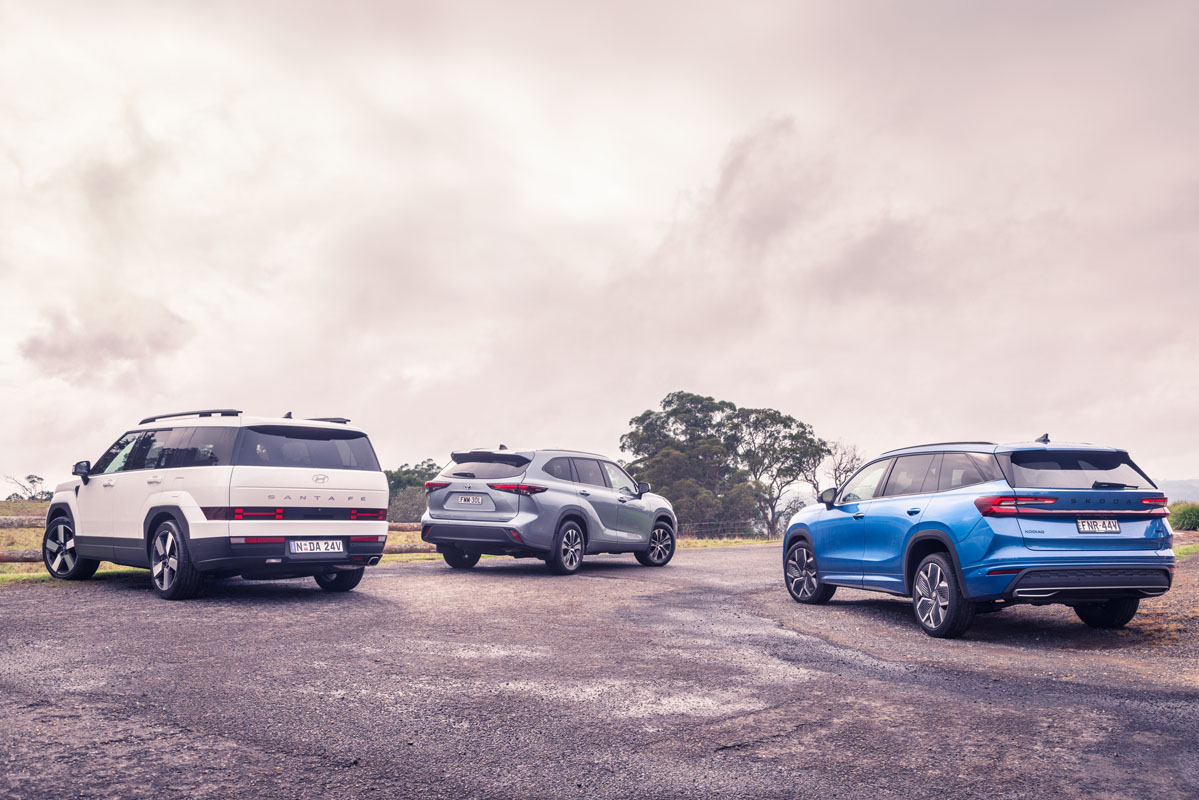
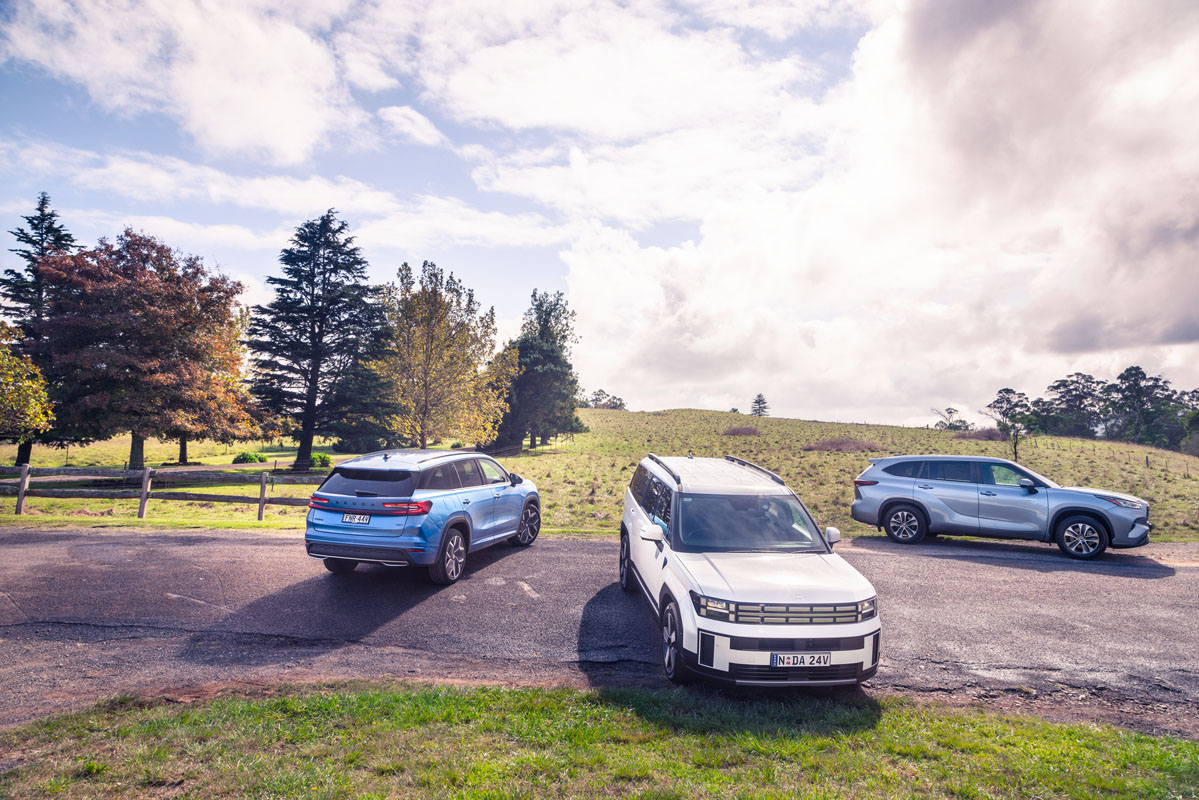
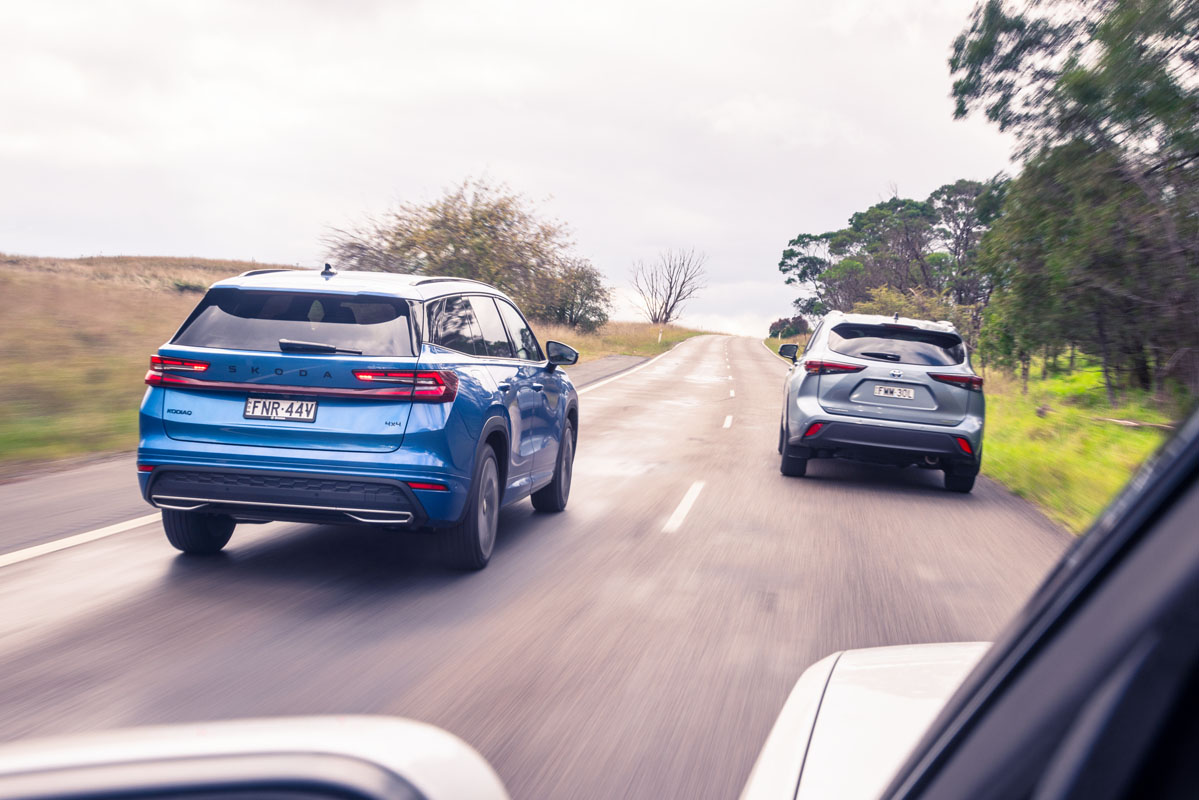
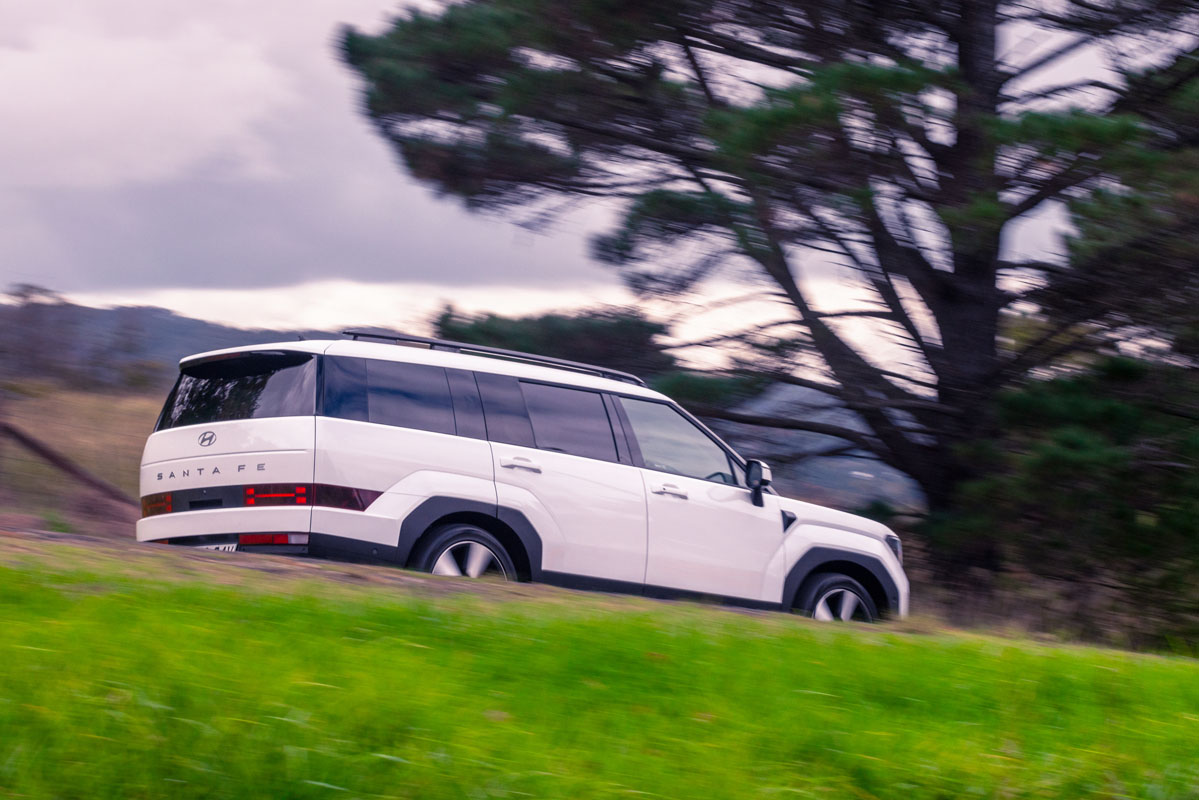
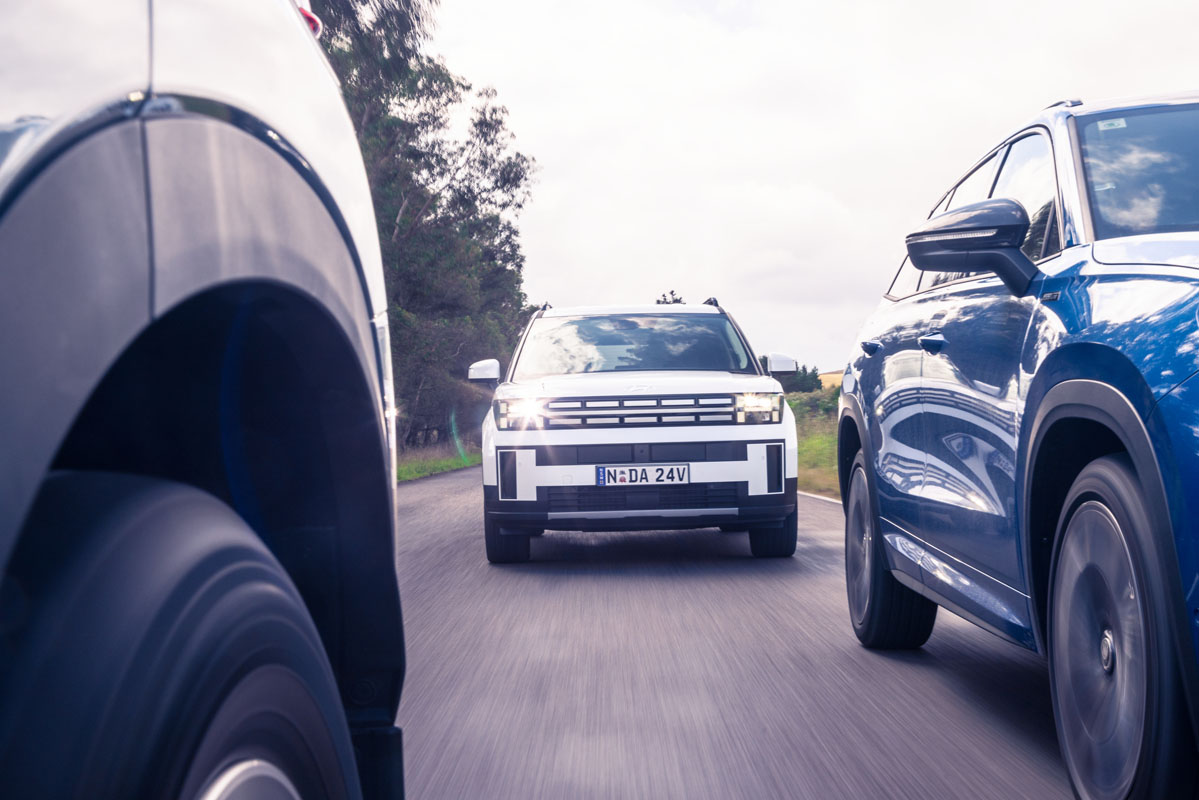

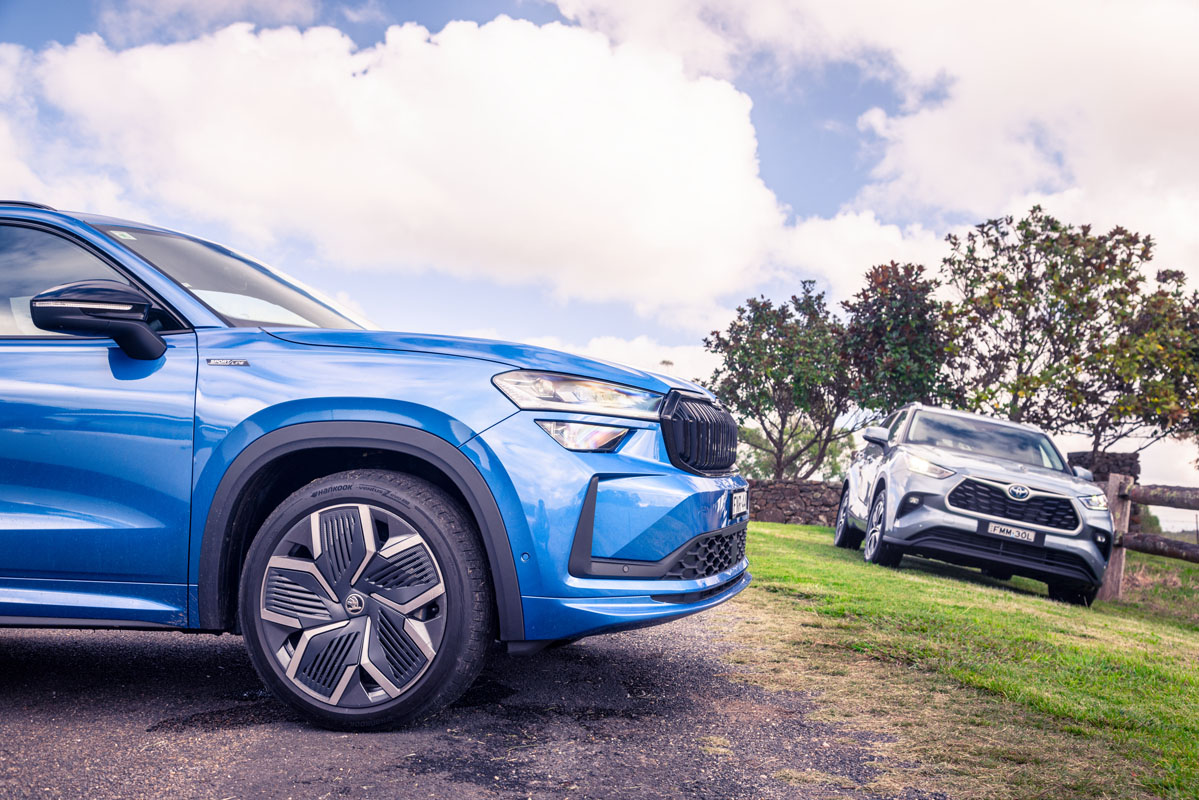
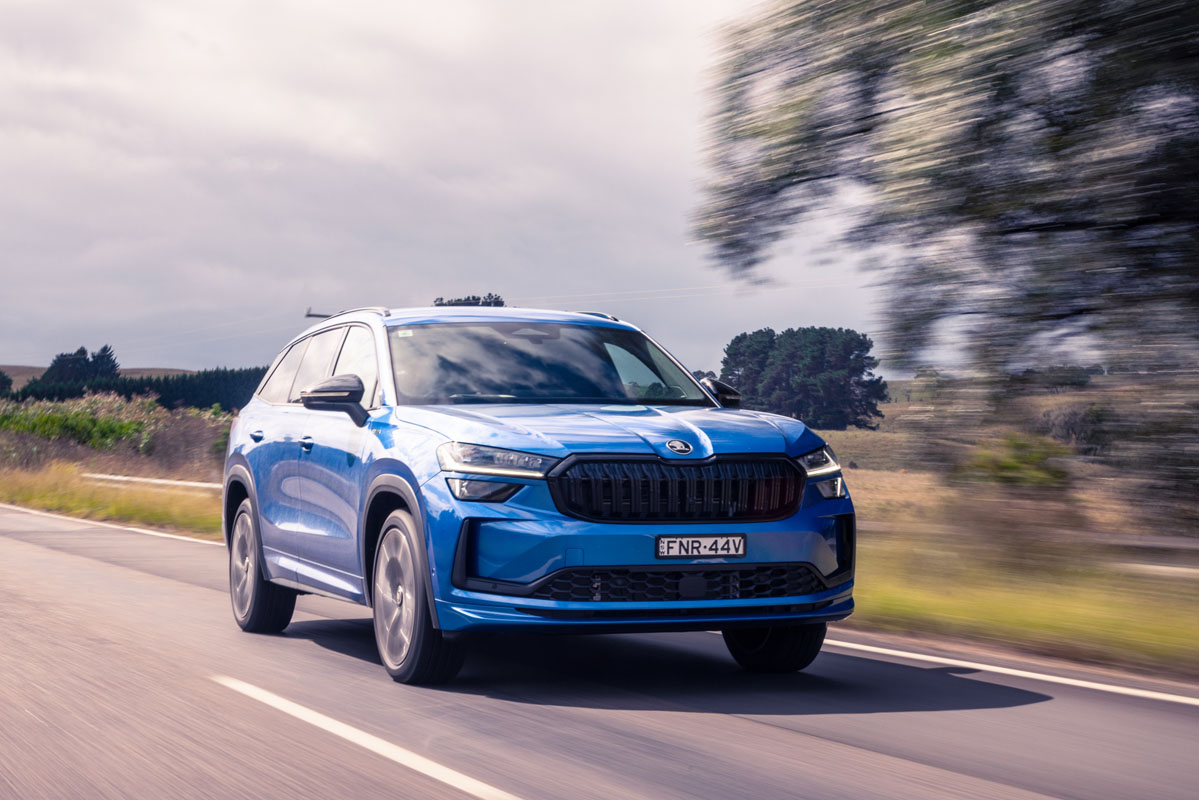
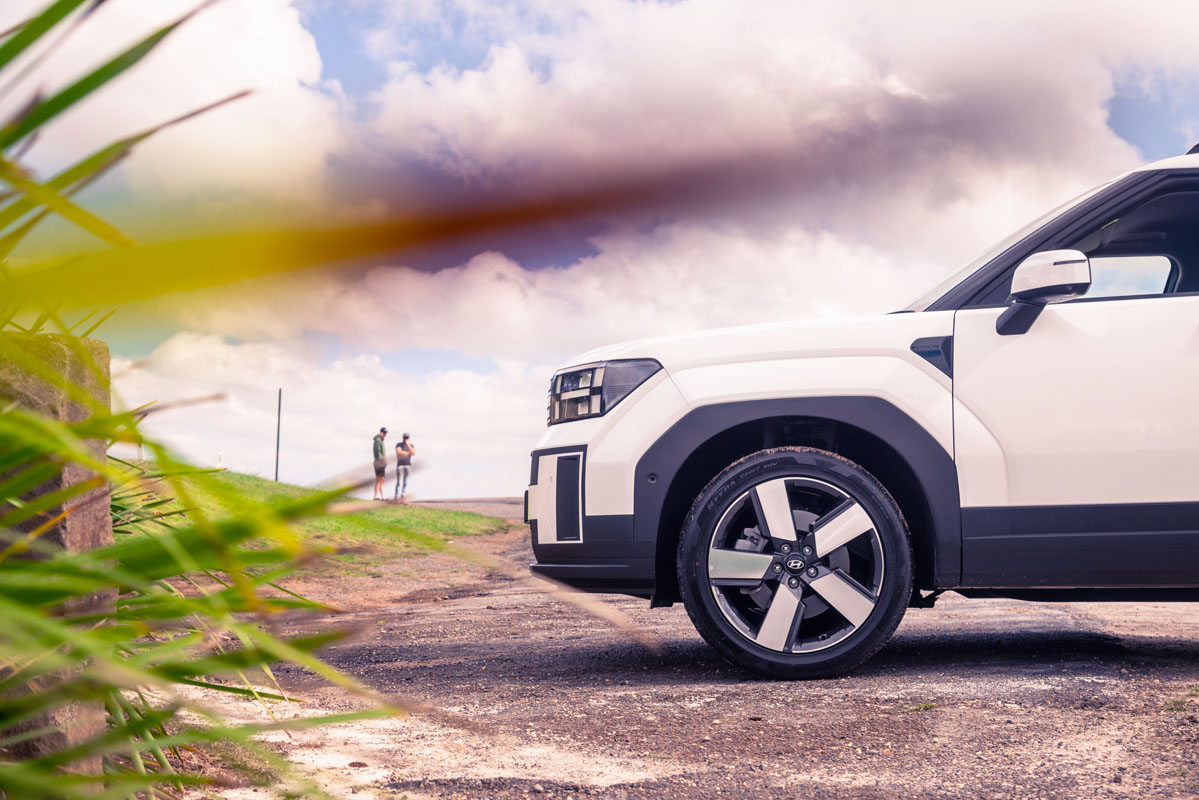
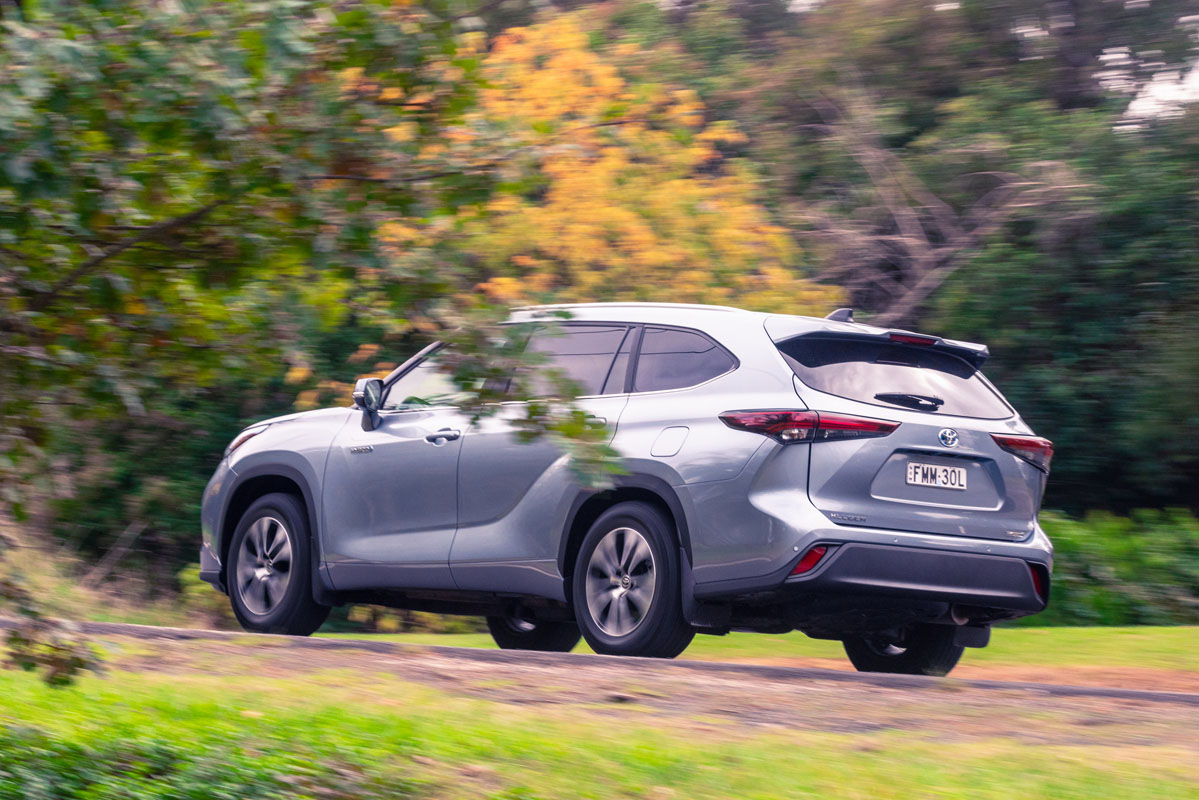
Ultimately, the requirements of your family will dictate the best seven-seat SUV of this bunch – and in truth, all three candidates have compelling reasons to edge ahead of their competitors.
— Sam Charlwood
How do these family SUVs compare on pricing and spec?
We’ve premised this test around the entry to mid-range versions of each model; we would ordinarily request three entry cars to keep things simple, but there wasn’t availability.
As such, the Santa Fe is the most affordable candidate, both for this test and in the showroom. The base front-drive Hyundai Santa Fe is priced from $53,000 plus on-road costs. The same model with a hybrid powertrain is an additional $2500.
The Skoda Kodiaq range opens at $54,990 plus on-road costs, for the entry Select. Here, we’re driving the mid-range Skoda Kodiaq Sportline, priced at $58,990 plus on-road costs – adding some additional tinsel for the outlay but retaining the same mechanical foundation.
Finally, the hybrid-only Toyota Kluger range now opens at $62,410 (plus on-road costs) for the GX, following a $1500 increase announced in June. A GX wasn’t available for this comparison, so we’ve made the sizeable jump to the mid-level Kluger GXL, priced at $71,390 (plus on-road costs).
With such a diverse grade mix, it’s tricky to determine which of this trio has the best value equation. If you were to preface value on the base model cars, it’s the Santa Fe that edges ahead of the Kodiaq by a nose, with the Kluger a distant third.
All three vehicles come equipped with three rows of seating (2-3-2), climate control, LED headlights, an electric tailgate, keyless entry and start, digital centre touchscreens and digital instrument clusters, Apple CarPlay and Android Auto.
Safety is likewise well sorted across all three competitors, with a full airbag count extending to curtain airbags that cover the third row, plus the latest driver aids and safety acronyms. Each is armed with a five-star ANCAP score, but as ever, the devil is in the detail; on-road testing reveals the intervention of some safety systems varies from mild mannered (Skoda) to plain annoying (Hyundai).
In terms of aftersales, there’s no clear winner. The Toyota and Hyundai are backed by five-year/unlimited kilometre warranties respectively, while the Skoda is backed by a seven-year/unlimited kilometre fixture. The Toyota is the most affordable to service over five years, at $1400, and the Skoda the dearest at $3000. The Hyundai bridges the two at $2405, the caveat being its 12-month/10,000km intervals are marginally more frequent (versus 15,000km).
Under the bonnet
Although all three competitors fundamentally source power from a four-cylinder petrol engine, their character traits are contrasting.
Toyota’s tried and tested hybrid technology bodes well for the Kluger’s efficiency, pairing a 2.5-litre naturally aspirated petrol engine with an electric motor and CVT to develop 142kW and 242Nm, together with a claimed fuel efficiency of 5.6L/100km.
Next, the Santa Fe adopts a 2.5-litre turbo-petrol driving the front wheels via a dual-clutch automatic. Power and torque is the best of our three, rated at 206kW and 422Nm, while claimed fuel efficiency is the worst, at 9.3L/100km.
Finally, the Skoda makes use of the Volkswagen Group’s long-running EA888 2.0-litre turbo-petrol (ala VW Golf GTI ), shuffling drive to all four wheels via a seven-speed dual-cluch auto. It makes 140kW and 320Nm in this application, together with a fuel consumption average of 9.2L/100km.
The Kodiaq claims a braked towing capacity of 2300kg braked, versus 2000kg braked for its competitors. The Kodiaq and Kluger both require minimum 95 RON premium unleaded fuel.
Family matters
With its standout exterior dimensions, you could be forgiven for thinking the Toyota Kluger offers the most compelling interior layout.
It’s certainly practical, with excellent spatial characteristics across the first and second rows, a flat floor and a cavernous 1150L boot area. There’s an ease of use to its dashboard centre fascia, which is emblazoned in simple hardwired buttons and switchgear, a traditional volume knob and dedicated HVAC controls.
The second-row slide-and-tilt function feels comparatively clunky, while the Toyota’s small instrument cluster font and native menus lack the execution of rivals. It’s consummate Toyota, covering the bases but not overextending itself with respect to design and layout.
The Kodiaq best embodies Skoda’s tagline of being ‘Simply clever’. Given its small stature in this company in terms of its overall dimensions, it does an admirable job of injecting practical elements into the space, like second-row window shades, second-row phone holders, an umbrella in the driver’s door, and a centre screen cleaner, to name a few. Moreover, it’s a lush cabin environment, with the best mix of materials and design highlights of the bunch.
There’s consideration around its dashboard dials, which offer umpteen adjustment and sit cleanly and legibly within the centre fascia. The digital instrument cluster is a nice touch, too, however the Skoda feels its smaller size inside the cabin, with less knee room and shoulder room and noticeably less third row space.
The Santa Fe sits somewhere in the middle in terms of materials and finish, with its tartan-finish seats (very VW Golf GTI-esque), curved centre screen display and the best mix of storage, including a mammoth open cubby underneath the centre console. There’s a generally durable premise to the plastics (especially those out of your line of sight), though its comfy chairs and thick-rimmed steering wheel feel anything like a base-spec car.
The Santa Fe mirrors elements of the Kodiaq’s design, with its gear shifter mounted on the steering column, plus a broader mix of textured materials and metallic highlights than the Kluger. Its brace of 12.3-inch curved screens (which join to make a big, extended display) are the best here for navigation and ease of use, too.
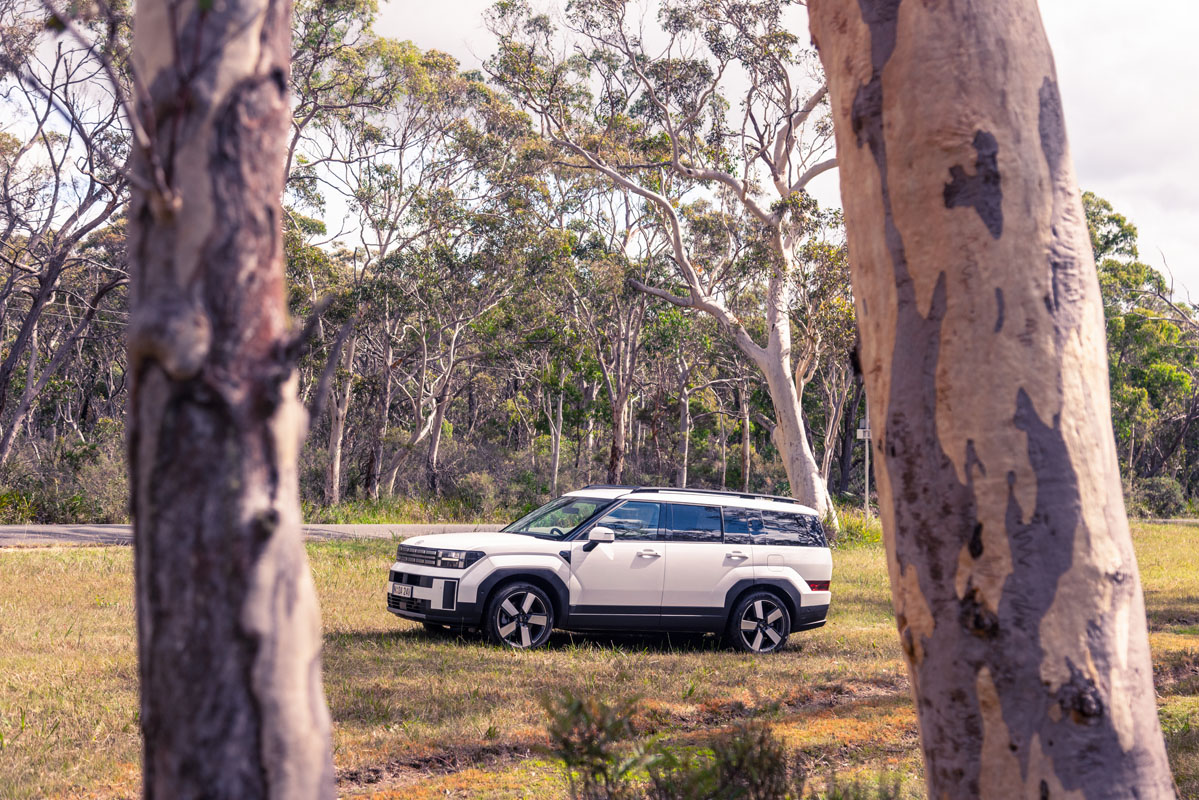

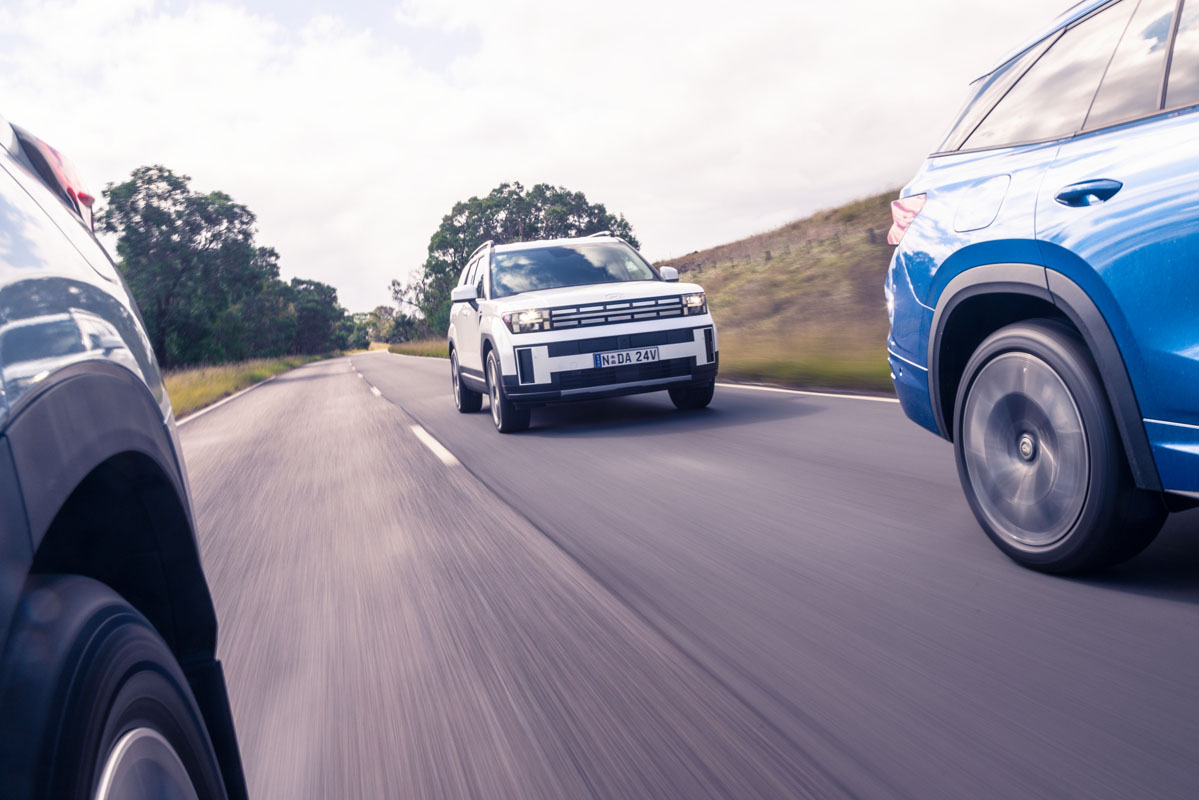

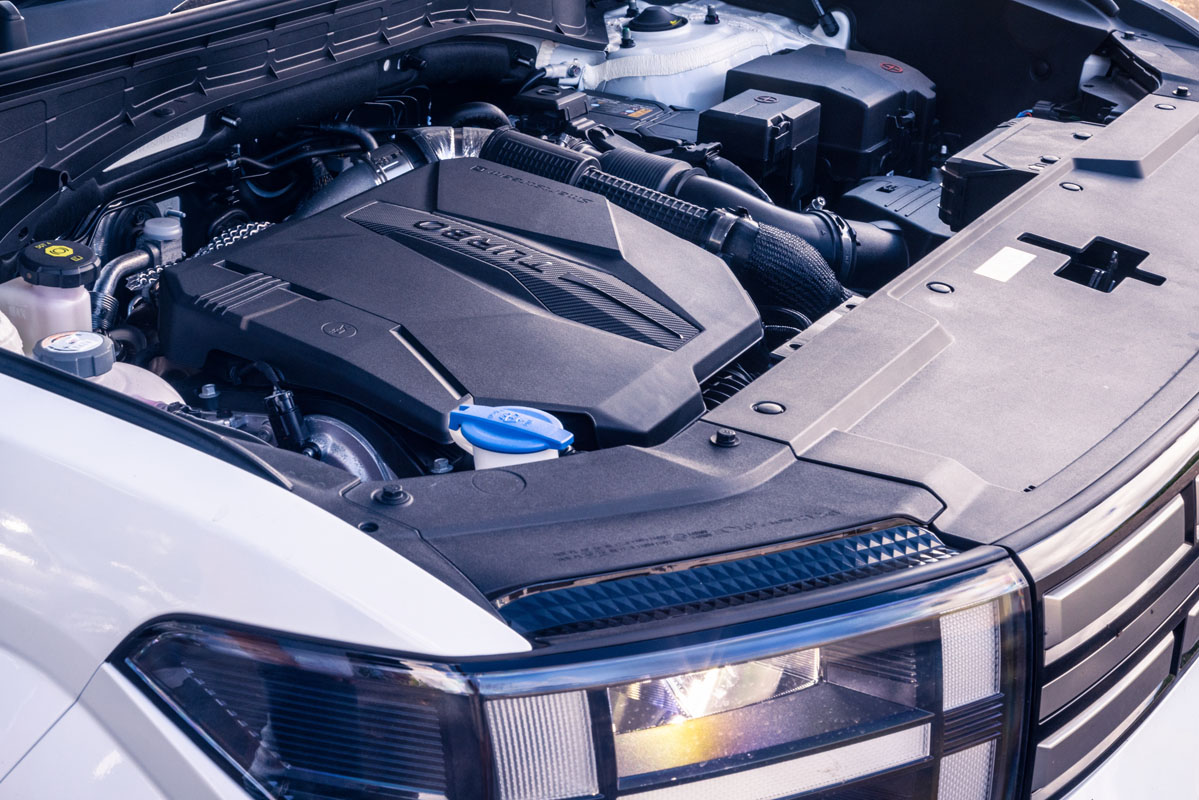
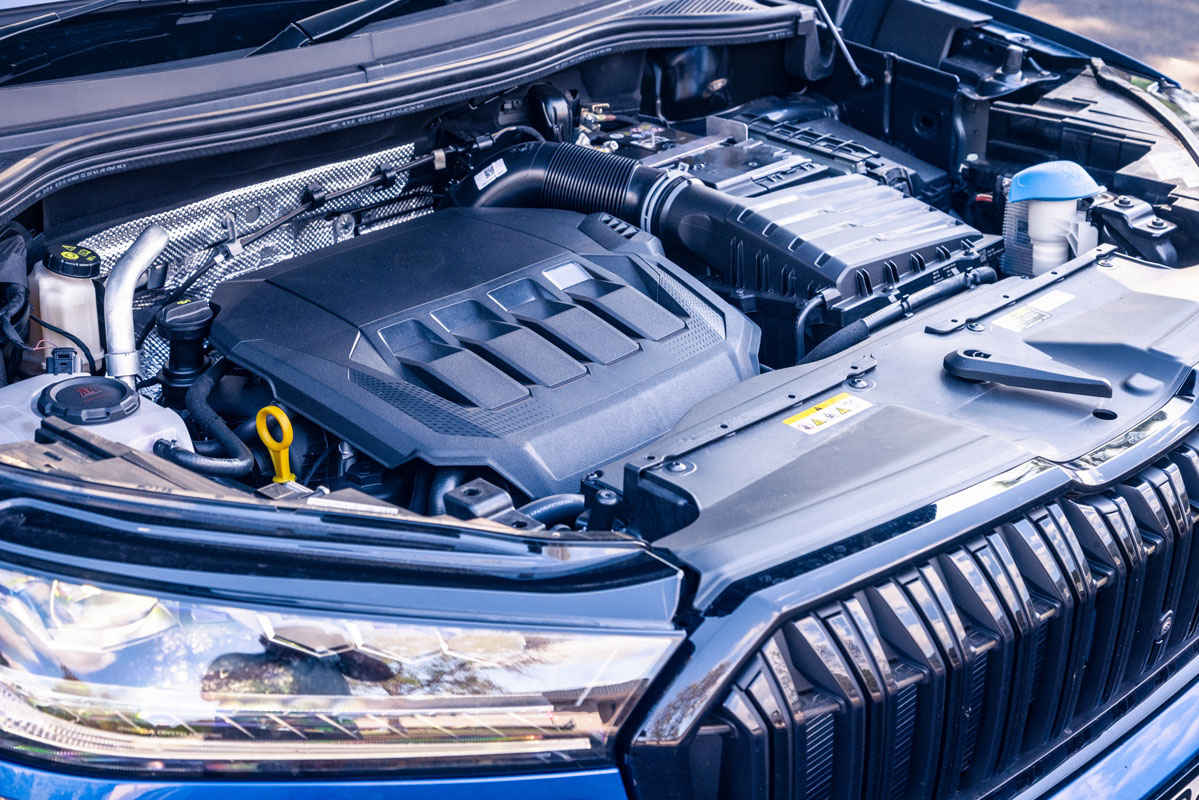

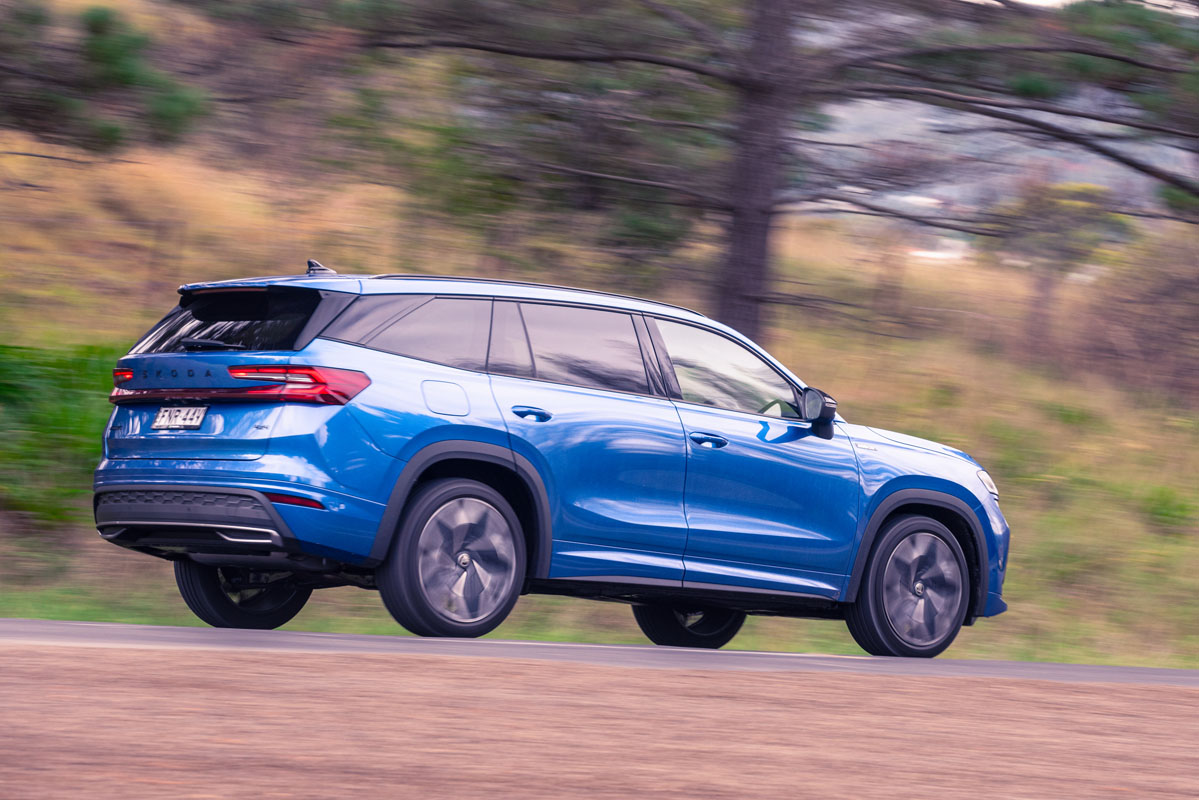
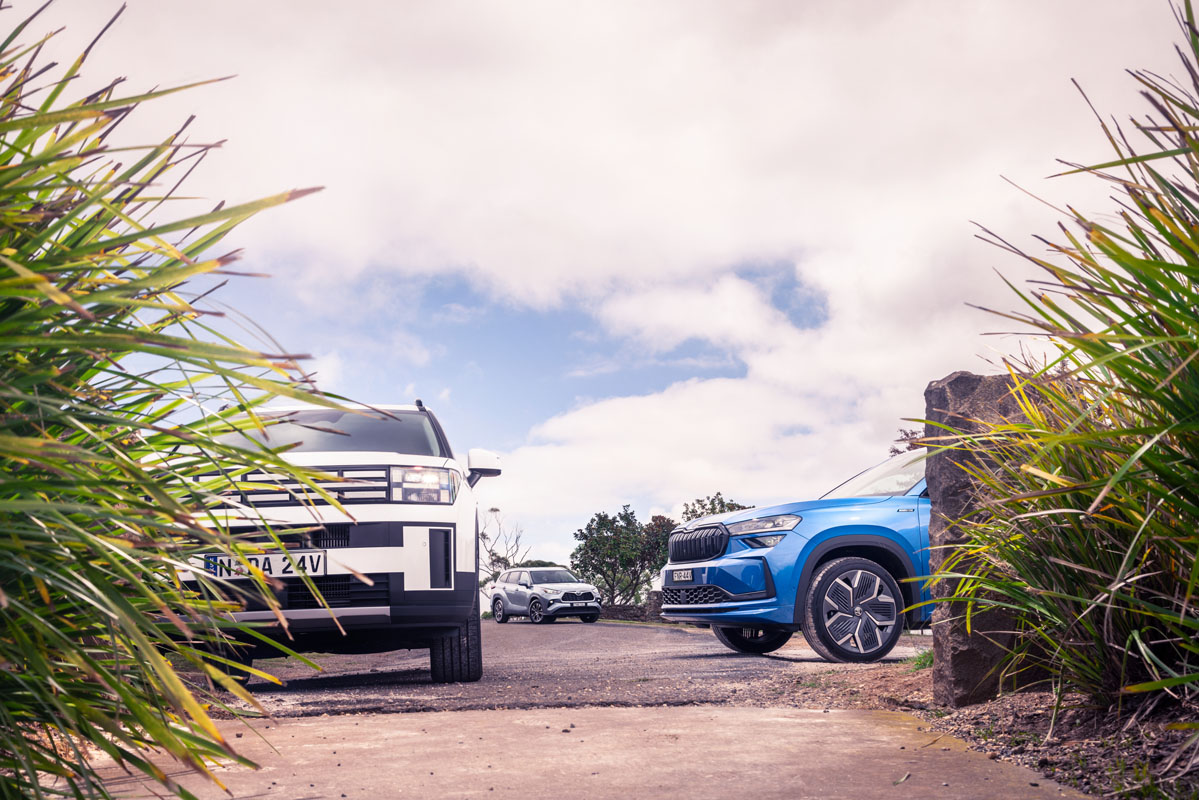
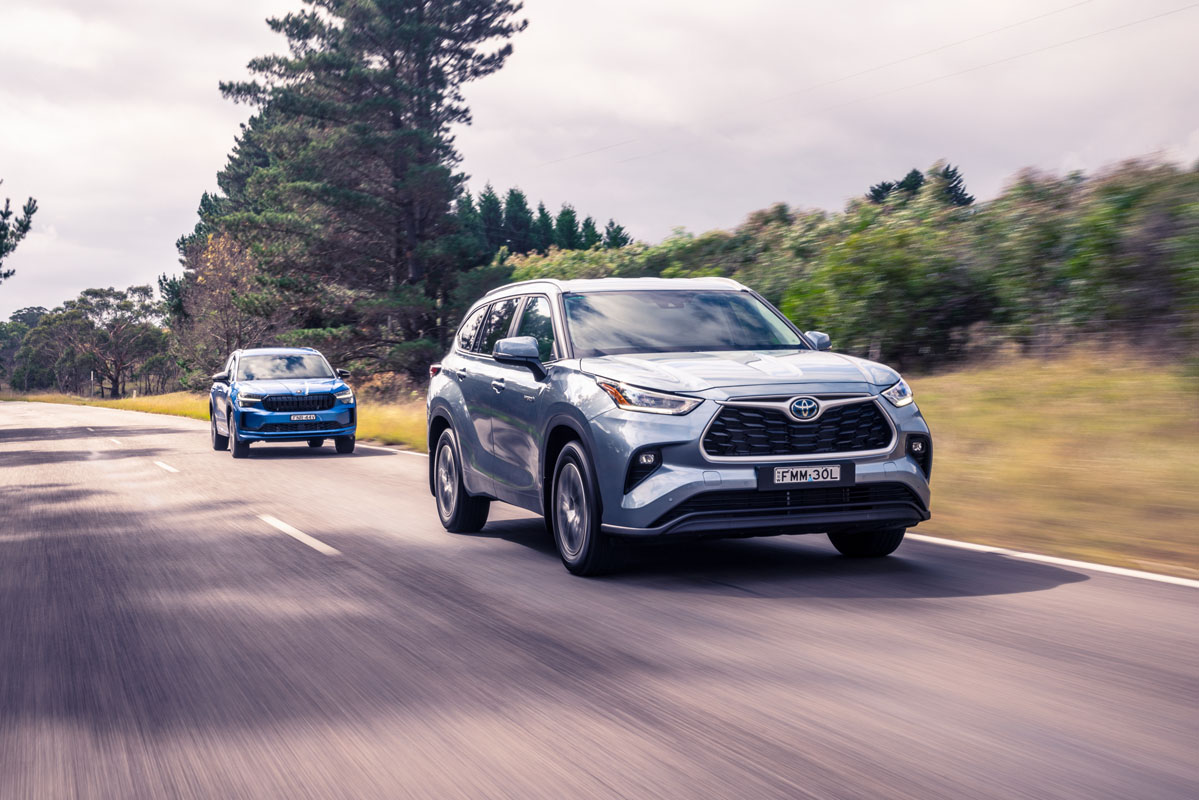
What seven-seat family SUV has the best third row?
It’s a convincing nod to the Hyundai Santa Fe where third-row seating is concerned. More space, greater passenger amenity and decidedly stronger packaging lend it an unequivocal advantage as a seven-seater in this comparison.
The Hyundai trumps both competitors with a lower boot loading height and larger aperture, the ability to slide and tilt the second row seat backs with a single button touch, plus a wider passageway through to the third row. Once there, the Hyundai stands alone with dedicated vents (the Skoda has none), dedicated fan speed (the Toyota has none), dedicated USB-C ports, and four cup holders.
A bigger glasshouse from the third row, plus unrivalled leg, knee and head room, hand the Santa Fe an easy win for seven-seat amenity.
Furthermore, the Hyundai is the only candidate in our trio to offer ISOFIX attachment points and top tether points across the sixth and seventh seats.
It offers a full-size alloy spare wheel underneath, too, matching the Toyota and besting the Skoda’s space-saver offering.
Driving and efficiency
Our comparison test takes us from Sydney’s inner-west to the beautiful Southern Highlands region of New South Wales.
The Skoda immediately imparts a sense of athleticism and lightness in our company of three, with well-weighted steering, deft control through corners, and meaningful tuning of its key controls. The 2.0-litre turbo-petrol is prone to some hesitation upon take-off – a symptom of the dual-clutch auto and some turbo lag – but percolates confidently thereafter, slicing through its seven ratios. The four-cylinder occasionally feels languid in the mid-range, however, struggling to shift the Kodiaq’s 1900kg kerb with enthusiasm – and that’s with a solitary person on board, not a family and their luggage.
The largely coarse-chip network of country roads common in this part of the world deals a few home truths with respect to the Skoda’s ride and handling mix. There’s a tendency for the smaller Czech entrant to thud over regular surface imperfections, and it is noticeably afflicted by road noise and wind noise. It lacks the vault-like road-holding of its contemporaries, which means a nippier around-town experience, but less open-road acumen.
If it’s a cosseting ride you’re after, the Kluger feels right at home. The Toyota trades nimbleness for a planted and secure on-road demeanour that offers excellent compliance over bumps and hushed acoustics. It feels like the largest SUV on-road, occupying a greater proportion of the lane and ultimately succumbing to its 2050kg kerb with approximate steering, slower changes in direction and more body roll.
The Kluger’s hybrid powertrain is an efficiency benchmark in this trio, securing an as-tested fuel economy average of 6.3L/100km (versus 9.2L for the Skoda and 9.6L for the Hyundai). In relaxed settings, the hybrid produces effortless zip off the line as the electric motor does the heavy lifting, casually segueing to the petrol motor if needed. Under heavier applications, the Toyota’s vocals can become strained as the engine and CVT work together to build strain.
If you treat the Skoda and Toyota as opposite ends of the scale, the Hyundai occupies a ride and handling middle ground – and it’s a treat. There’s meaningful precision and feedback to the steering, and considered tuning of the key controls; even the accelerator pedal feels nice under foot. The Hyundai straddles mixed surfaces with aplomb; it’s the quietest of our three on-road and offers a firm-but-controlled demeanour over niggly bumps, avoiding the temptation to thud over all but the harshest of obstacles.
That said, the Hyundai is also dynamically sound – offering confident turn-in, admirable body control and grip. The engine is a peach, offering the kind of linear torque curve that isn’t reliant on downshifts and big throttle inputs; you can instead rest on the engine and know it will pull cleanly through the rev range.
The Santa Fe is afflicted with some noticeable torque steer, however, (the steering wheel tugging at the hands) during heavier bursts of acceleration. The other obvious annoyance is the tuning and intervention of its safety systems. The fact you need to turn them off each time you start the car – in a bid to retain your sanity – tells you they need a revisit, no matter the ANCAP requirements.
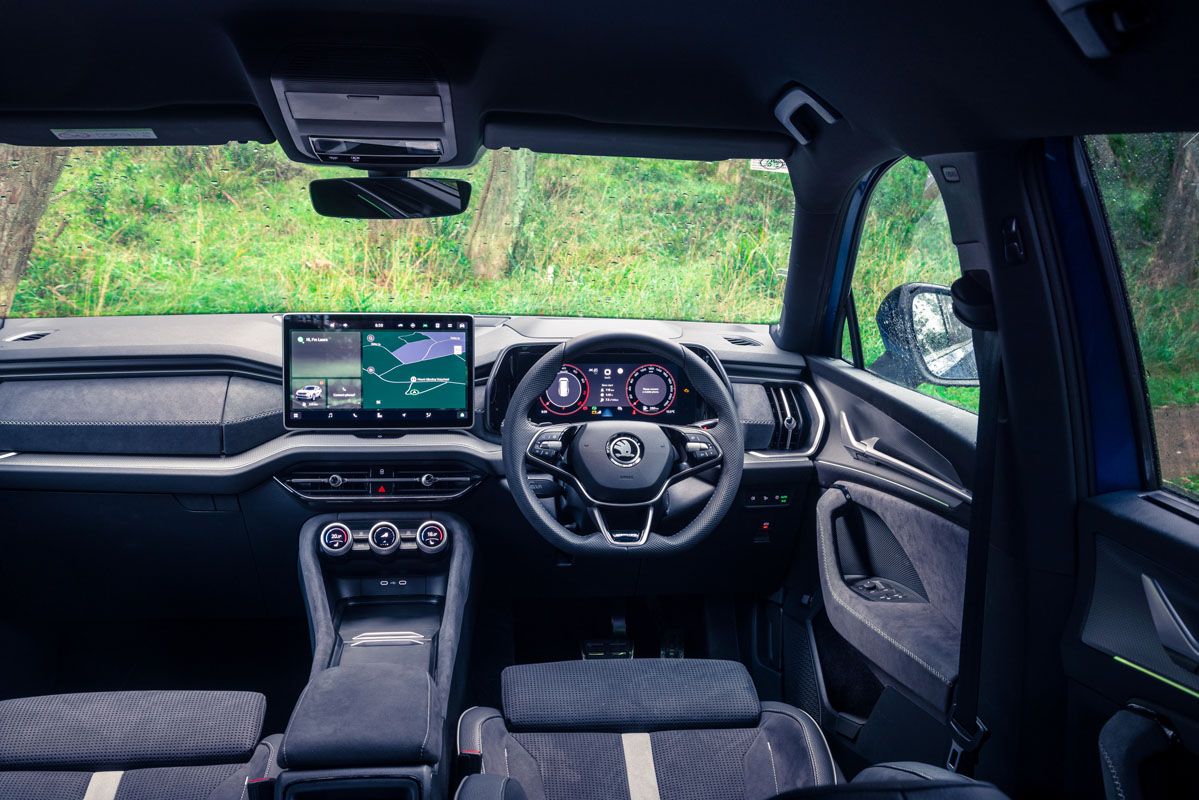
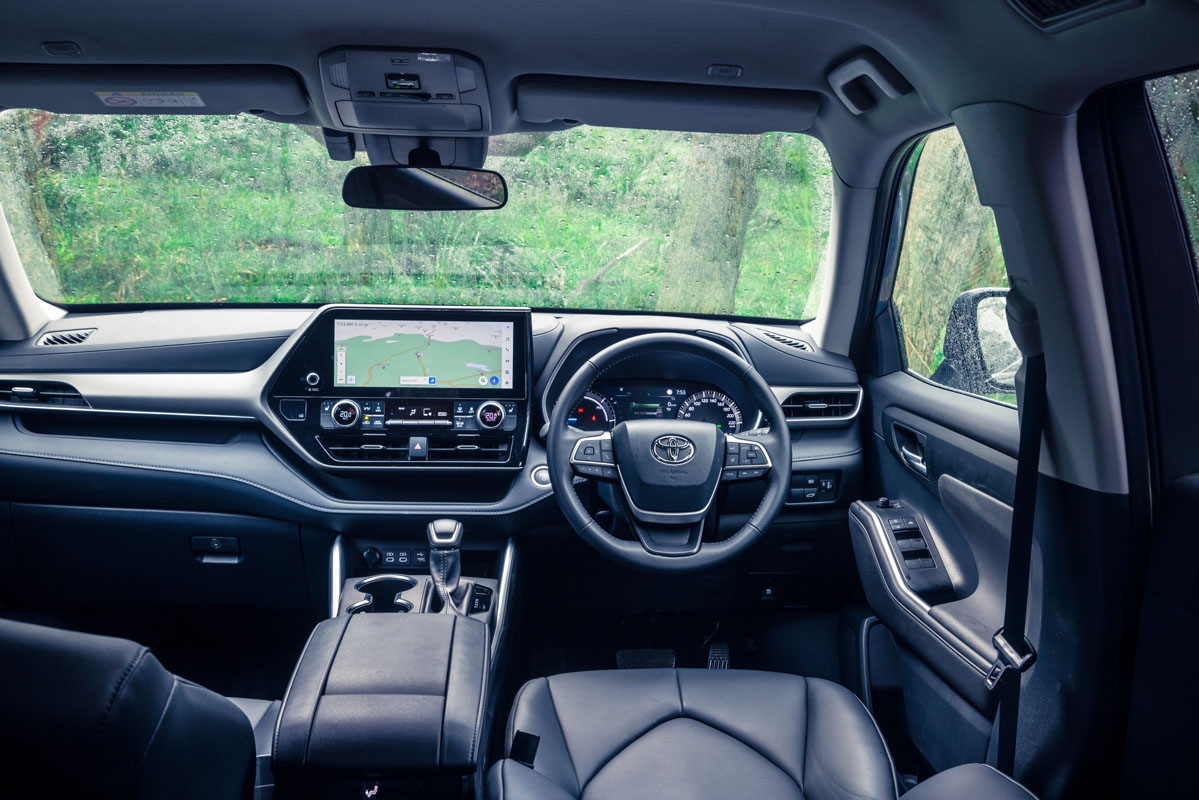
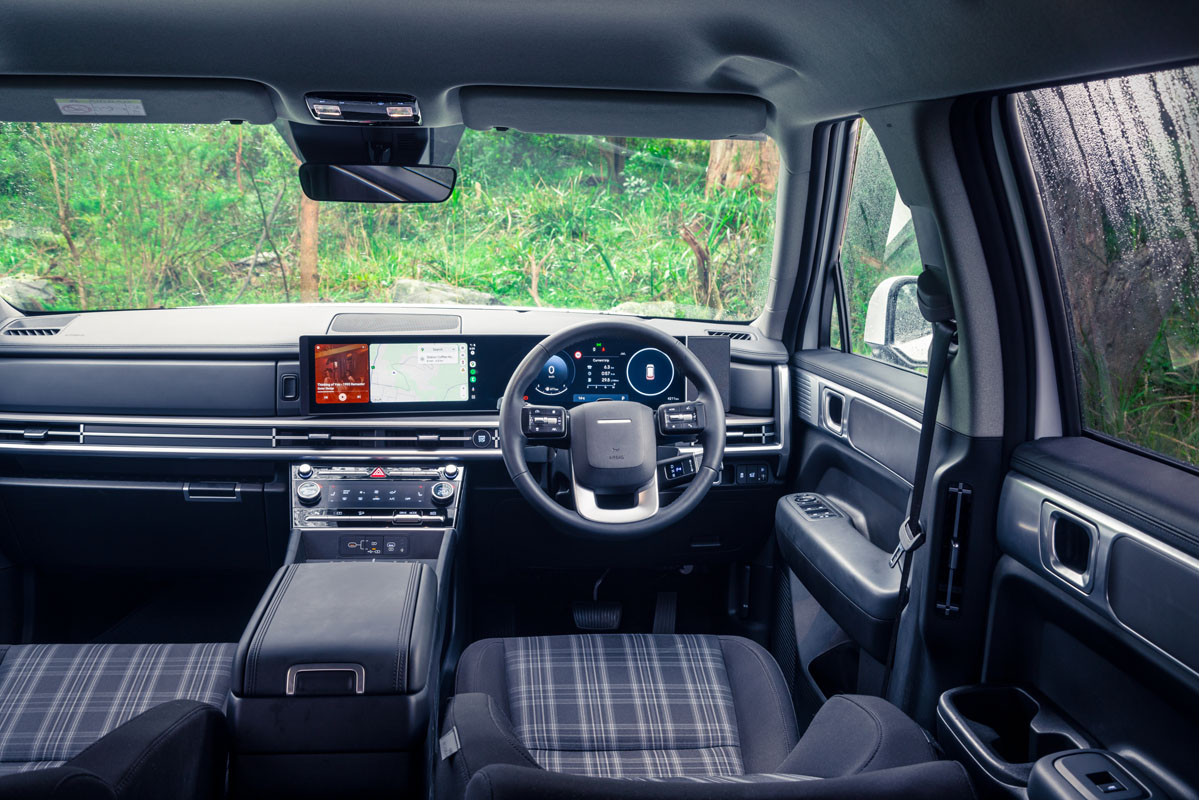


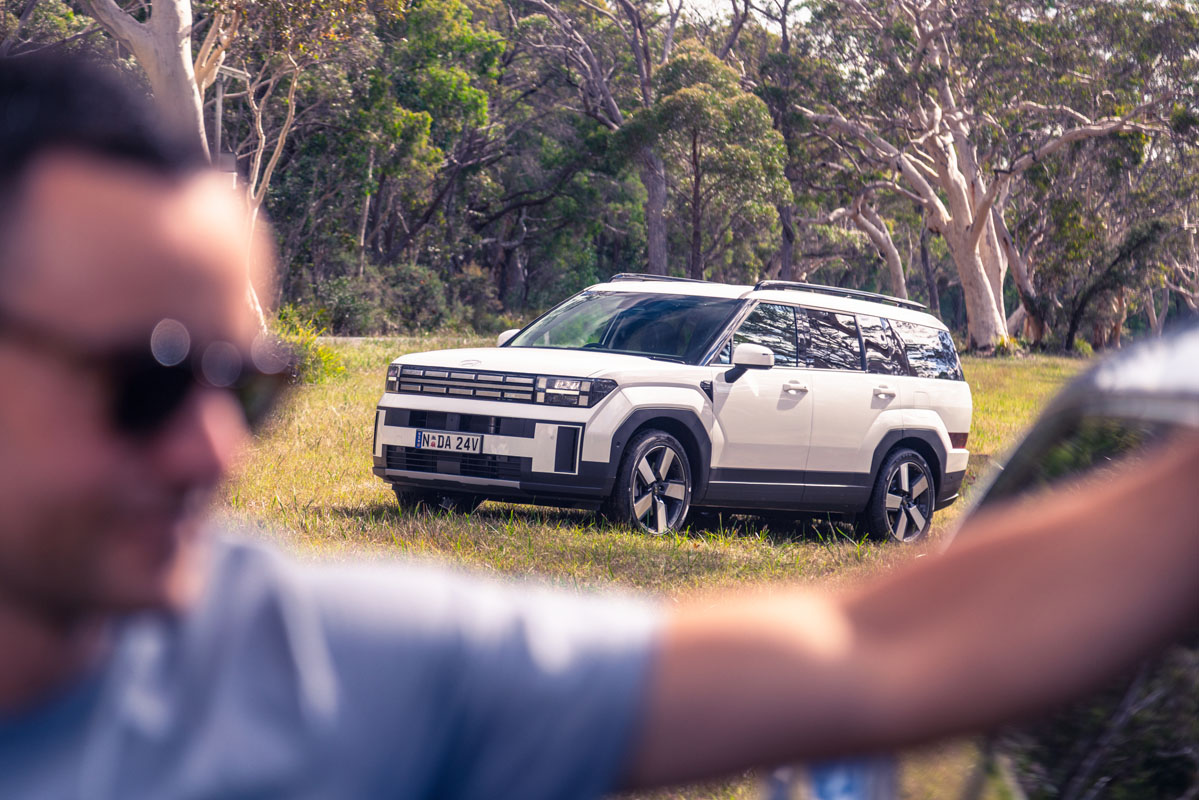

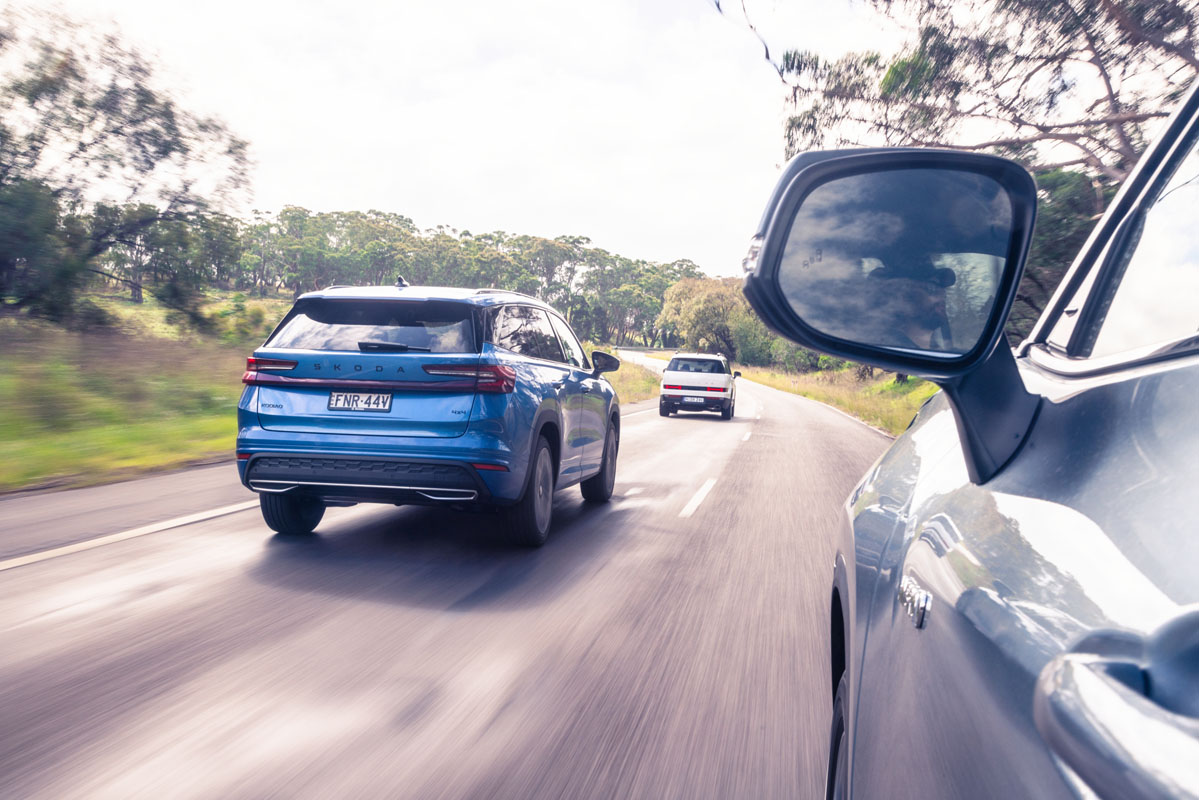
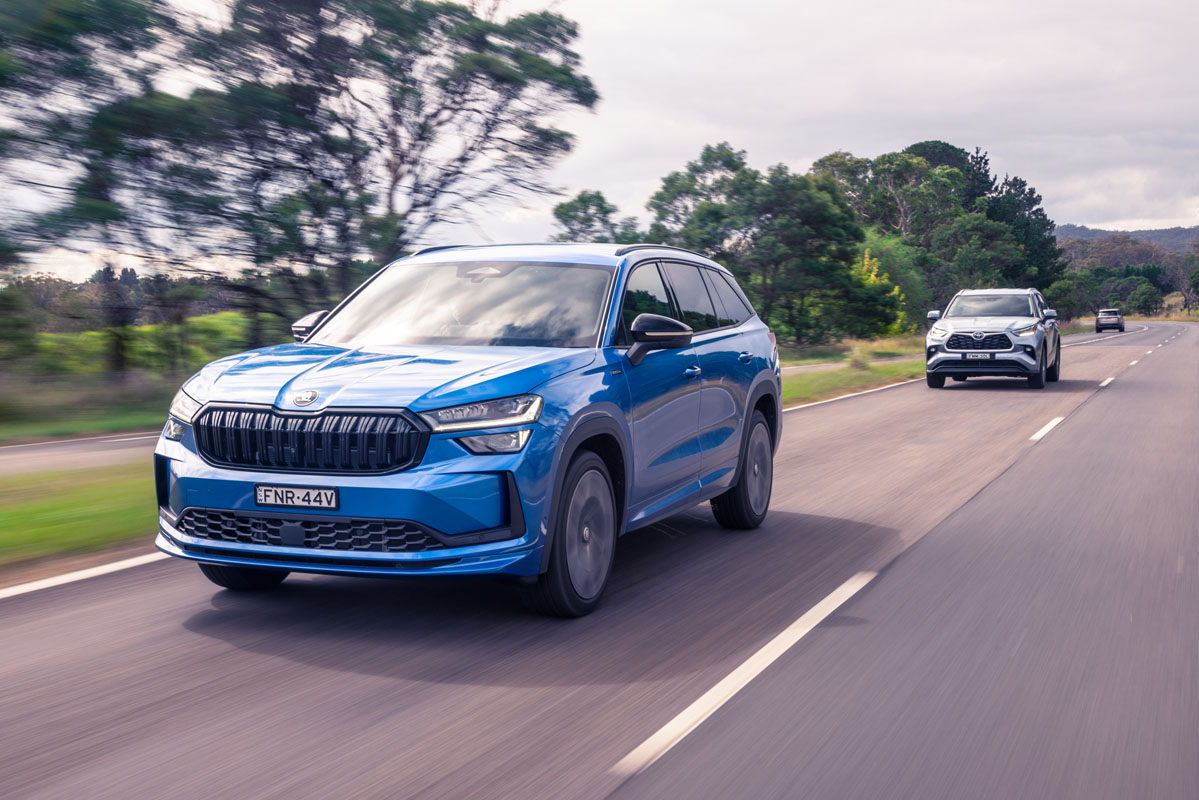
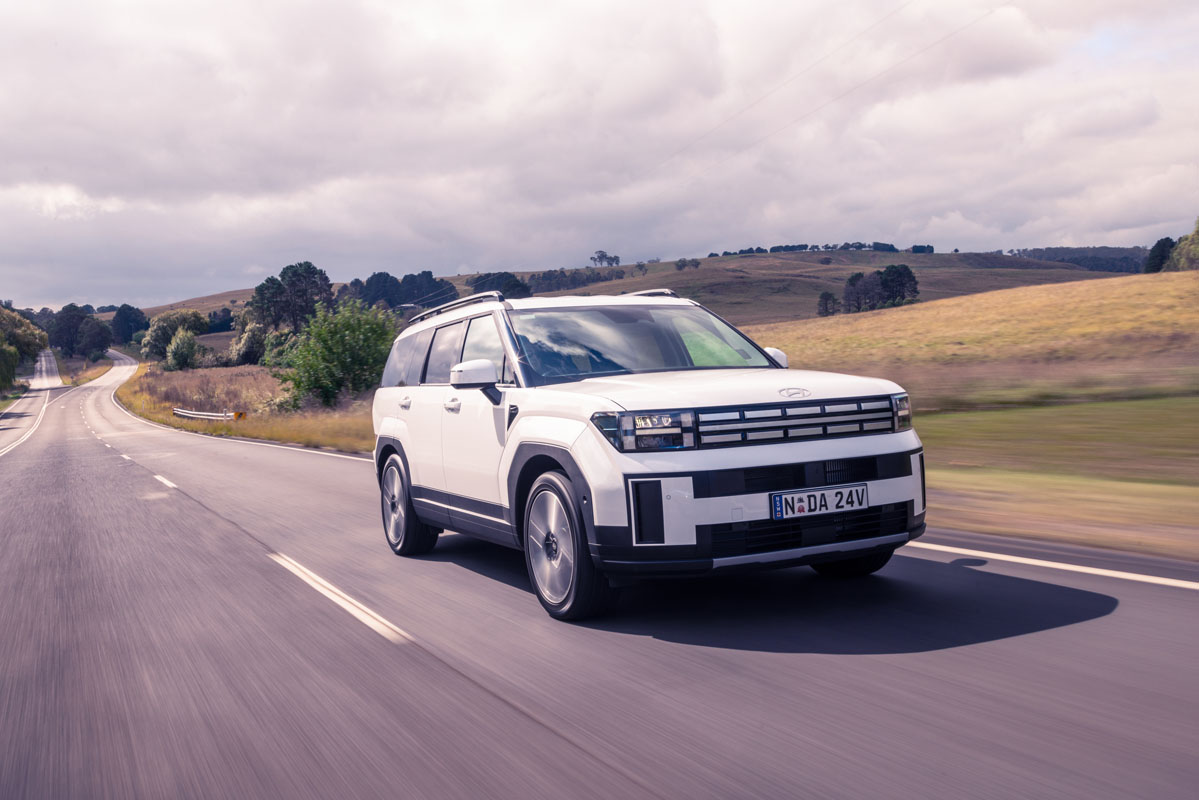
Which large seven-seat SUV is best? The NRMA verdict
Ultimately, the requirements of your family will dictate the best seven-seat SUV of this bunch – and in truth, all three candidates have compelling reasons to edge ahead of their competitors.
The Kluger is about as sound as the Toyota formula gets; a safe, efficient and pragmatic choice – if a little uninspiring. The Skoda’s 5+2 spatial layout and Euro charm make it a strong left-field candidate, though one that asks you to make some compromise with respect to space and performance.
It means the Hyundai gets the nod in this comparison. It makes the best use of its space, occupies the best balance of driving dynamics and comfort, is the most affordable, and the easiest to live with.
It’s also a genuine seven-seat affair, the car best versed to tackle the school run or take the family on holidays away.
Hyundai Santa Fe
Engine: 2.5-litre turbo-petrol four-cylinder
Transmission: Eight-speed dual-clutch automatic
Power: 206kW
Torque: 422Nm
Fuel consumption: 9.3L/100km
Spare wheel: Full-size
ANCAP: Five star (2024)
Price: $53,000 (plus ORCs)
Skoda Kodiaq Sportline
Engine: 2.0-litre turbo-petrol four-cylinder
Transmission: Seven-speed dual-clutch automatic
Power: 140kW
Torque: 320Nm
Fuel consumption: 9.2L/100km
Spare wheel: Space-saver
ANCAP: Five star (2024)
Price: $58,990 (plus ORCs)
Toyota Kluger GXL
Engine: 2.5-litre four-cylinder hybrid
Transmission: CVT automatic
Power: 142kW
Torque: 422Nm
Fuel consumption: 5.6L/100km
Spare wheel: Full-size
ANCAP: Five-star (2021)
Price: $71,390 (plus ORCs)






